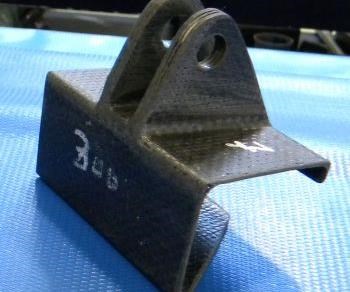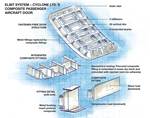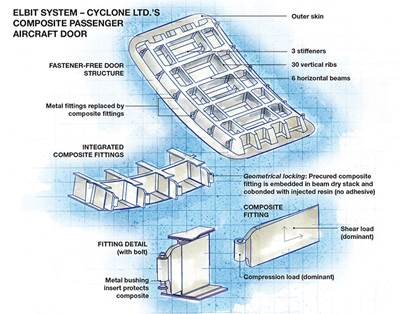Fastener-free, composite aircraft door and control surfaces
All-composite, integrated structures using RTM cut weight and cost by more than 30%.
As reported in the High Performance Composites magazine article, “Cutting the cost of integrated composite aerostructures,” Cyclone Ltd. (Karmiel, Israel), a subsidiary of Elbit Systems – Cyclone Ltd. (Haifa, Israel), has developed an all-composite passenger aircraft door that uses no metal fasteners and is made in a one-shot, resin transfer molding (RTM) process.
Cyclone reports it has successfully demonstrated the manufacture of this door design, using its patented, geometrically-locked, composite fittings to achieve a totally fastener-free structure, as well as a 30% reduction in weight and cost vs. similar-sized aluminum and “black aluminum” composite doors in use today.
Cyclone developed the patented fittings in order to replace metallic fasteners used in bonded joints to satisfy regulatory requirements. The issue is that catastrophic failure of doors would jeopardize safe flight, thus they are considered flight-critical or primary structures in aircraft. All primary structures which use adhesively bonded joints must provide redundancy in that load path in case the bonds fail. Thus, most primary composite structures today either use only mechanical fasteners or use them to meet redundancy requirements in addition to bonded joints. However, they require significant post-fabrication machining and assembly, and also add weight because laminates must be “beefed-up” to accommodate the fastener holes throughout without weakening the structure.
Cyclone displayed the integrated, all-composite door at JEC World 2016 (Mar. 8-10, Paris, France).Now that Cyclone has demonstrated the efficient manufacture of this door, it will proceed with cyclic pressurization tests to simulate the in-service life and mature nondestructive inspection (NDI) methods that have been developed.
Integrated Composite Control Surfaces
Meanwhile, Cyclone has extended this technology to integrated composite control surfaces for aircraft (see Technical Paper). As a demonstrator, Cyclone redesigned and fabricated a 1200 mm root segment of an outer aileron for a Heron-TP class unmanned aerial vehicle (UAV) that Cyclone developed and manufactured from 2005 to 2012. The chord of this segment varied from 280 mm at the root to 250 mm outboard and had a maximum height of 47mm.
The baseline composite aileron comprised a cored upper skin and lower skin, a monolithic main spar, six front ribs and three aft ribs, all autoclave-cured, as well as a kit of three aluminum fittings and their supports.
The new structure featured a single integrated skin stiffened by a three-spar array to eliminate ribs and designed to optimally withstand torsion, which is the dominant load. Pre-cured composite fittings made from out of autoclave (OOA) carbon fiber/epoxy prepreg were placed between the dry preform layers to achieve geometrical locking for redundancy and withstand flatwise tension loads. This damage tolerant design aimed to improve the aileron’s durability and reliability. A key aspect was to minimize parts, the derived number of interfaces and the number of holes, and for the composite layers to be continuous as much as possible.
A minimal number of standard materials were used, and core was eliminated, to reduce cost. Advanced RTM injecting liquid resin at high-pressure was chosen to produce a high-quality, integrated structure that is de-molded near-net shape with high repeatability and reduced cost compared to classic prepreg processing.
Feasibility testing, including standard engineering and FEA load analyses, physical tensile, bending and torsion loading, fitting pull-out tests, adapted and validated NDI and production cost analysis has shown this approach successful. Twenty (20) aileron root segment parts with composite fittings were manufactured and tested, successfully demonstrating:
- Fiber-to-resin ratio of 50% by volume;
- Dimensional deviation of ±0.3 mm;
- Weight of 1600 g with deviation of 1.5%;
- No porosity or delaminations in micrographs;
- Lead time reduction of 50%;
- Cost reduction of 35%.
Related Content
Large-format 3D printing enables toolless, rapid production for AUVs
Dive Technologies started by 3D printing prototypes of its composite autonomous underwater vehicles, but AM became the solution for customizable, toolless production.
Read MoreCarbon fiber in pressure vessels for hydrogen
The emerging H2 economy drives tank development for aircraft, ships and gas transport.
Read MoreComposite rebar for future infrastructure
GFRP eliminates risk of corrosion and increases durability fourfold for reinforced concrete that meets future demands as traffic, urbanization and extreme weather increase.
Read MorePlant tour: Spirit AeroSystems, Belfast, Northern Ireland, U.K.
Purpose-built facility employs resin transfer infusion (RTI) and assembly technology to manufacture today’s composite A220 wings, and prepares for future new programs and production ramp-ups.
Read MoreRead Next
Cutting the cost of integrated composite aerostructures
A unitized all-composite aircraft door concept is realized in one shot with no fasteners.
Read MoreCW’s 2024 Top Shops survey offers new approach to benchmarking
Respondents that complete the survey by April 30, 2024, have the chance to be recognized as an honoree.
Read MoreComposites end markets: Energy (2024)
Composites are used widely in oil/gas, wind and other renewable energy applications. Despite market challenges, growth potential and innovation for composites continue.
Read More





























